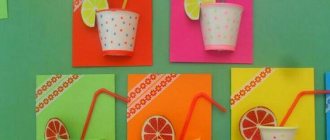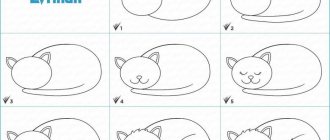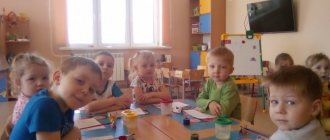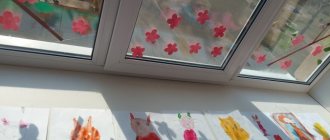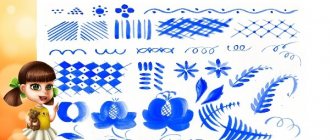MAGAZINE Preschooler.RF
Tasks:— continue to teach children to take care of household items;
— activate children’s vocabulary on the topic “Dishes”;
- consolidate the use of nouns in diminutive form;
- learn how to compose a composition yourself;
- develop technical skills - skillfully use a brush (paint with the tip of the brush, holding it in a vertical direction, with the whole brush, move freely in different directions)
- cultivate a desire to help people in difficult times.
Material and equipment:
multimedia, book by K.I. Chukovsky “Fedorino Grief”, ball, teapot and cup, Su-Jok springs, cut pictures, gouache, brushes, water jars, napkins, album sheets.
Preliminary work:
— reading the fairy tale by K. I. Chukovsky “Fedorino’s grief”;
- conversation about dishes;
- games with doll dishes.
GCD move:
Educator: - Guys, listen carefully, I will read you excerpts from one fairy tale (“Fedorino’s grief”)
Educator: - Did you recognize this fairy tale? What is it called? /"Fedorino's grief"
- Who wrote this fairy tale? / K.I. Chukovsky
Educator: - That's right, and now I suggest you watch a short excerpt from this cartoon.
Educator: (after watching) - Why did the dishes run away from Fedora? She didn’t wash her, beat her, etc.
— Why did the dishes decide to return to Fedora? The dishes took pity on Fedora, forgave, etc.
Educator: - Now, let's stand freely on the carpet and warm up. Physical exercise “Utensils” is being held.
Here is a big shiny teapot. Very important, like a boss. Here are the porcelain cups, very fragile poor things. Here are porcelain saucers, just knock and they will break. Here are the silver spoons, Here is the plastic tray - He brought us the dishes.
Educator: - Fedora broke a lot of dishes. And now I suggest you collect her dishes from the fragments.
D/I “Collect a picture”
Game task: collect a picture.
Progress of the game: children collect cut dishes on the table.
Educator: - Well done, you completed the task. Now stand in a circle. I will take turns throwing the ball to you and naming the dishes, and you will name them affectionately. Whoever names correctly sits down at the table.
Educator: - You guys remember that Fedora broke a lot of dishes. Let's help her and draw new dishes for her, namely a teapot and a cup.
Examining the teapot and cup.
Educator: - Let's stretch our Su-Jock fingers with springs before we start drawing.
Drawing of a cup and a teapot by children. Decorating them.
Questions for self-analysis of children:
—Which cup and teapot did you like best? Why?
—Which cup and teapot turned out to be the brightest? Why?
— What would you advise Fedora to do with the dishes after tea? And why? Wash the dishes so she doesn't run away from her again.
| Next > |
On the topic: methodological developments, presentations and notes
A brief summary of the morning meeting for older preschoolers on the topic “Gzhel patterns.”
Educational objectives: Teach children to create patterns on a sheet of paper in the form of a folk product - a tray, using characteristic elements of Gzhel painting: flowers, leaves, dots, curls; Learn images.
Abstract of GCD in the preparatory group. Topic: “Painting a teapot with the Gzhel pattern” Goal: Continue to introduce Gzhel masters and their creativity. Teach children how to draw a Gzhel rose. Zach.
Notes on drawing on the topic Dishes Making a pattern on dishes Program tasks Educational: · Learn to independently outline the content of a pattern, come up with details, choose palettes.
This material on artistic and aesthetic development will be useful for middle-aged children.
Source
Easy lesson
It is better to paint plates in any style with acrylic paints, since they are the most resistant to external influences - water, sunlight, dust. In addition, they are convenient to work with, since their consistency resembles gouache and does not require additional thinning agents or special brushes (for example, compared to oil and tempera).
To fix the paint and maintain brightness for a long time, it is recommended to coat the top of the finished product with a special colorless acrylic varnish.
Painting a ceramic plate can be done using different techniques, it all depends on the skills, imagination and desire of the author.
Beginners and unconfident craftsmen are recommended to use stencils to accurately apply patterns. They can be downloaded, printed and cut out, or purchased from craft stores. Painting using this technique can be done either with paints using a brush or a cotton swab, or with a special marker.
This technique is well suited for children, as it does not require special drawing skills. All that is needed is to fix the stencil picture on the plate, for example, with tape, and paint over the “empty” places.
A simple but elegant dot painting is done with contour paints, which are sold in tubes and do not require dilution. The tubes are equipped with spouts, which makes the job of applying dots and fine lines much easier.
Related article: Kumihimo weaving patterns for beginners with photos and videos
For painting using dot technique you will need:
- plain ceramic plate (preferably white);
- degreasing agent (alcohol, nail polish remover);
- contour paints;
- sample;
- carbon paper or soft pencil;
- brushes;
- palette;
- acrylic lacquer.
Progress:
- Wipe the plate with alcohol or another product. You can use a cotton pad for this;
- Using carbon paper, transfer the design onto the dishes. To do this, combine it with carbon paper, secure it on a plate and trace the lines with a pencil. You can also make a homemade carbon copy by painting over the back of the drawing;
- Pressing on the tube, apply a contour at equal distances. Their diameter depends on the pressure applied. As a rule, large points are made on the main lines (large parts) first, and then small ones. The result should be patterned “lines” consisting of dots;
- After the pattern is completed, the product must be dried naturally for 24 hours. If desired, the finished painted plate can be varnished.
Both ceramics and glass are well suited for such painting. You can first paint the plate with paints, make a background or draw a plot picture, and then additionally process the lines with contour paints, highlighting the necessary details.
It is more convenient to secure the design on a glass plate with tape on the outside or inside, depending on the purpose of the dish.
If the plate is going to be used as a decoration, then the side where the paint is applied does not matter. To use the plate for its intended purpose, it is better to apply paint from the outside and fix the picture from the inside.
Wooden plates are also painted with acrylic and then varnished. As a rule, people do not eat from such dishes, so they can become an excellent wall decoration, and can also be used for fruit (painted wooden dishes).
Perhaps many people associate wooden utensils - plates and spoons - with folk painting, for example, with Khokhloma or Gorodets. Mastering folk painting is not difficult. The main thing is to understand the basic principle of each painting, its “zest”.
Related article: Making a mezzanine
Decorative drawing “Painting dishes for a doll”
Elena Bashkatova
Decorative drawing “Painting dishes for a doll”
Objectives: teach children to paint dishes with gouache paints , beautifully combining colors and arranging the pattern according to shape. Improve brush technique: move the brush freely and confidently along the pile, repeating the general outline of the silhouette. Strengthen the ability to prepare the desired shades of color on a palette. To develop children’s aesthetic perception and sense of rhythm.
Preliminary work: examining the ornament, painting dishes at home and in the store , didactic games “Match a Pair”
,
“What’s missing”
, examination of illustrations and photographs of the ornaments
of dishes , tea sets, collective modeling from plasticine “Tea set for favorite toys”
,
decorative drawing of various types of ornaments.
Summary of OOD on HER for children 4–5 years old. Decorative drawing “Decorating a Sweater” Purpose: To teach children to implement the planned pattern in their work. Objectives: Educational: To strengthen children’s ability to decorate items of clothing using.
Decorative drawing with elements of the applique “Napkins for your beloved mother” Objectives: teach children to draw patterns on round and square napkins; show children options for combining decor in color and shape;
Decorative drawing “Blizzard-Blizzard” Targets: develop imagination, cultivate interest in drawing Objectives: Educational: Cultivate interest in drawing Developmental:.
Painting dishes with Mordovian patterns. Master class It is advisable to introduce preschool children to the Mordovian national culture and objects of folk and applied art. Summary of the lesson “Painting dishes based on Gzhel” Purpose: to develop the ability to convey the originality of color (a combination of white and blue, to consolidate the ability to work with a brush Demonstration.
Source
